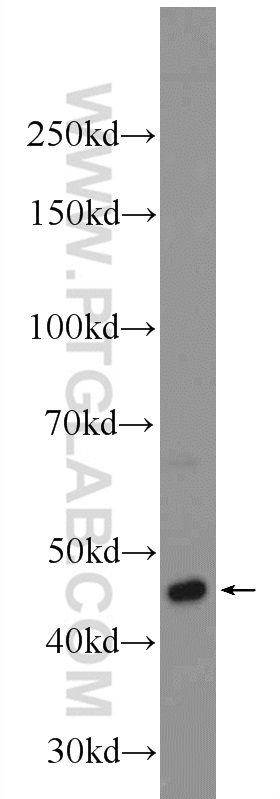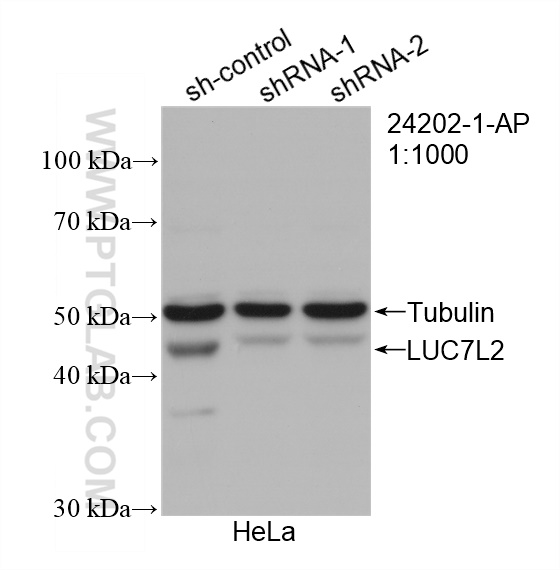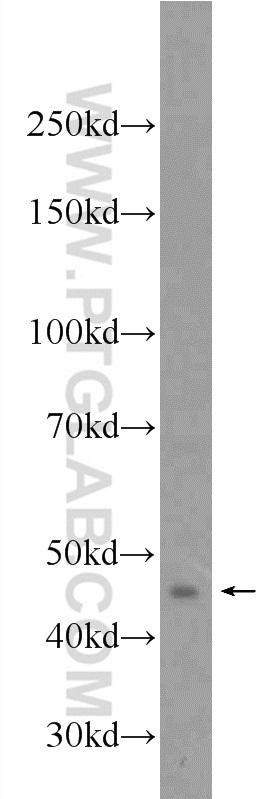验证数据展示
经过测试的应用
| Positive WB detected in | K-562 cells, HeLa cells |
| Positive IF/ICC detected in | A431 cells |
推荐稀释比
| 应用 | 推荐稀释比 |
|---|---|
| Western Blot (WB) | WB : 1:500-1:3000 |
| Immunofluorescence (IF)/ICC | IF/ICC : 1:300-1:1200 |
| It is recommended that this reagent should be titrated in each testing system to obtain optimal results. | |
| Sample-dependent, Check data in validation data gallery. | |
产品信息
24202-1-AP targets LUC7L2 in WB, IF/ICC, ELISA applications and shows reactivity with human samples.
| 经测试应用 | WB, IF/ICC, ELISA Application Description |
| 经测试反应性 | human |
| 免疫原 | LUC7L2 fusion protein Ag21135 种属同源性预测 |
| 宿主/亚型 | Rabbit / IgG |
| 抗体类别 | Polyclonal |
| 产品类型 | Antibody |
| 全称 | LUC7-like 2 (S. cerevisiae) |
| 别名 | LUC7B2, LUC7 like 2 (S. cerevisiae), CGI-74, CGI-59, CGI 74 |
| 计算分子量 | 392 aa, 47 kDa |
| 观测分子量 | 46 kDa |
| GenBank蛋白编号 | BC017163 |
| 基因名称 | LUC7L2 |
| Gene ID (NCBI) | 51631 |
| RRID | AB_2879455 |
| 偶联类型 | Unconjugated |
| 形式 | Liquid |
| 纯化方式 | Antigen Affinity purified |
| UNIPROT ID | Q9Y383 |
| 储存缓冲液 | PBS with 0.02% sodium azide and 50% glycerol , pH 7.3 |
| 储存条件 | Store at -20°C. Stable for one year after shipment. Aliquoting is unnecessary for -20oC storage. |
背景介绍
RNA-binding protein LUC7L2 as a negative regulator of DNA virus-triggered innate immune response. Mechanistically, LUC7L2 directly bound to intron 3 of MITA precursor messenger RNA, inhibited its splicing, and promoted its nonsense-mediated decay, leading to its downregulation at the protein level (PMID:34155193). Moreover, LUC7L2 as a component of the U1 snRNP capable of reprogramming cellular metabolism through changes in alternative pre-mRNA splicing (PMID:33961773).
实验方案
| Product Specific Protocols | |
|---|---|
| WB protocol for LUC7L2 antibody 24202-1-AP | Download protocol |
| IF protocol for LUC7L2 antibody 24202-1-AP | Download protocol |
| Standard Protocols | |
|---|---|
| Click here to view our Standard Protocols |



